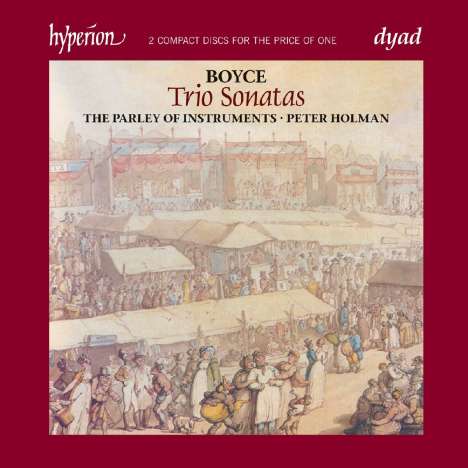William Boyce: Triosonaten Nr.1-15 auf 2 CDs
Triosonaten Nr.1-15
Herkömmliche CD, die mit allen CD-Playern und Computerlaufwerken, aber auch mit den meisten SACD- oder Multiplayern abspielbar ist.
Lassen Sie sich über unseren eCourier benachrichtigen, falls das Produkt bestellt werden kann.
- Künstler:
- The Parley of Instruments, Parley of Instruments Baroque Orchestra, Holman
- Label:
- Hyperion
- Aufnahmejahr ca.:
- 1995
- UPC/EAN:
- 0034571120638
- Erscheinungstermin:
- 23.7.2010
Ähnliche Artikel
Mit der Veröffentlichung 1747 von seinen „Twelve Sonatas for Two Violins with a Bass for the Violoncello or Harpsicord“ bestätigte Boyce seine Position als einer der führenden Musiker des damaligen England.
Das Wiederaufleben der englischen Triosonate ist sein Verdienst, da die Sammlung als geeignetes Material für sowohl professionelle als auch
Amateur-Orchester angesehen wurde.
Über 400 Künstler, darunter namhafte Komponistenkollegen, baten um eine Kopie und bestätigen damit die Qualität dieser Werke.
Product-Information:
The music of William Boyce has always retained a special place in the English repertory, it being written of him that, 'there is an original and sterling merit in his productions, founded as much on the study of our own old masters, as on the best models of other countries' (Burney).
This recording is of the Twelve Sonatas for Two Violins with a Bass for the Violoncello or Harpsicord, published in 1747, and three unpublished Trio Sonatas newly edited from a manuscript in the Fitzwilliam Museum, Cambridge. These particularly attractive works boast a wide range of stylistic features and forms and for many years held centre-stage in England as masterpieces in the genre. The performances are divided between a solo quartet and the full Parley of Instruments, so ensuring over two hours of varied and inspiring listening.
Rezensionen
'The works, large and small, have an air of sweet reasonableness. The fugues are warmly greeted but never aggressively attacked; the string tone in the slow movements is very appealing, sweet and well blended. The two solo violins carry on an urbane and charming dialogue, their voices twining in and out of each other like those of a long-married couple who can anticipate what the other will say. In the final Gigues everyone lets their hair down for an end-of-concerto romp. Attractive music performed with skill' (BBC Music Magazine)
'Yet another treasurable document of England's musical heritage' (Gramophone)
Rezensionen
D. Steppuhn in FonoForum 2/97: "Die Stücke fesseln in dieser lebendigen, farbigen, erdigen Darstellung der vielfältigen Stilarten und besitzen jenes Quent- chen "unkonventioneller Widerborstigkeit", das eine Wiedergabezeit von mehr als zwei Stunden nie langweilig werden läßt."Disk 1 von 2 (CD)
Triosonaten Nr. 1-15
-
1 Nr. 1, 1. Satz: Largo
-
2 Nr. 1, 2. Satz: Fuga (Allegro)
-
3 Nr. 1, 3. Satz: Allegro ma non troppo
-
4 Nr. 2, 1. Satz: Andante vivace
-
5 Nr. 2, 2. Satz: Adagio
-
6 Nr. 2, 3. Satz: Allegro
-
7 Nr. 2, 4. Satz: Allegro ma non troppo (Giga)
-
8 Nr. 3, 1. Satz: Largo
-
9 Nr. 3, 2. Satz: Fuga (Allegro assai)
-
10 Nr. 3, 3. Satz: Adagio
-
11 Nr. 3, 4. Satz: Tempo di Minuetto
-
12 Nr. 4, 1. Satz: Gratioso
-
13 Nr. 4, 2. Satz: March (Grave)
-
14 Nr. 4, 3. Satz: Tempo di Gavotta
-
15 Nr. 5, 1. Satz: Allegro
-
16 Nr. 5, 2. Satz: Largo
-
17 Nr. 5, 3. Satz: Fuga (Allegro assai)
-
18 Nr. 6, 1. Satz: Adagio
-
19 Nr. 6, 2. Satz: Vivace (Allemanda)
-
20 Nr. 6, 3. Satz: Adagio
-
21 Nr. 6, 4. Satz: Affettuoso
-
22 Nr. 7, 1. Satz: Andante
-
23 Nr. 7, 2. Satz: Fuga (Alllegro)
-
24 Nr. 7, 3. Satz: Adagio
-
25 Nr. 7, 4. Satz: Allegro (Giga)
-
26 Nr. 8, 1. Satz: Largo
-
27 Nr. 8, 2. Satz: Allegro (Allemanda)
-
28 Nr. 8, 3. Satz: Siciliana
-
29 Nr. 8, 4. Satz: Tempo di Minuetto (Allegro)
Disk 2 von 2 (CD)
-
1 Nr. 9, 1. Satz: Adagio ad libitum
-
2 Nr. 9, 2. Satz: Fuga (Allegro)
-
3 Nr. 9, 3. Satz: Canone (Grave)
-
4 Nr. 9, 4. Satz: Spirituoso
-
5 Nr. 10, 1. Satz: Adagio
-
6 Nr. 10, 2. Satz: Allegro
-
7 Nr. 10, 3. Satz: Largo
-
8 Nr. 10, 4. Satz: Tempo di Minuetto (Allegro)
-
9 Nr. 11, 1. Satz: Adagio
-
10 Nr. 11, 2. Satz: Fuga (Allegro)
-
11 Nr. 11, 3. Satz: Affettuoso (Hornpipe)
-
12 Nr. 11, 4. Satz: Allegro (Giga)
-
13 Nr. 12, 1. Satz: Moderato
-
14 Nr. 12, 2. Satz: Tempo di Gavotta
-
15 Nr. 12, 3. Satz: Dolce (Minuetto) Tempo di Gavotta
-
16 Nr. 13, 1. Satz: Adagio (Preludio)
-
17 Nr. 13, 2. Satz: Vivace (Fuga)
-
18 Nr. 13, 3. Satz: Largo
-
19 Nr. 13, 4. Satz: Giga (Allegro)
-
20 Nr. 13, 5. Satz: Tempo di Minuetto (Allegro)
-
21 Nr. 14, 1. Satz: Largo
-
22 Nr. 14, 2. Satz: Vivace
-
23 Nr. 14, 3. Satz: Grave
-
24 Nr. 14, 4. Satz: Gavotta (Allegro)
-
25 Nr. 15, 1. Satz: Largo andante (Allegro)
-
26 Nr. 15, 2. Satz: Vivace (Corrente)
-
27 Nr. 15, 3. Satz: Adagio (Sarabanda)
-
28 Nr. 15, 4. Satz: Gavotta (Allegro)
-
29 Nr. 15, 5. Satz: Minuetto









